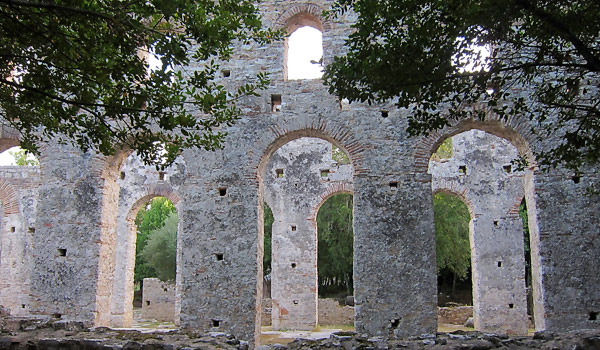
Butrint, situated in the far south of Albania was the first place in the country to be listed as a UNESCO World Heritage Site. Having been inhabited since prehistoric times, it gives visitors the unique opportunity to quite literally take a walk through centuries of Albanian history, all in one place.
Now the ancient city, sits within national park covering 94 m2 of terrain, including lakes, wetlands, salt marshes, plains, reed beds, and islands.

Once inhabited by the Chaonians, it later became a Roman city and a bishopric in the ancient realm of Epirus. It fell into decline in the Middle Ages after a major earthquake resulted in widespread and devastating flooding. Today it stands proudly as a reminder of the diversity of Albanian history, 14 km from Sarande and a stone’s throw from the Greek border. Surrounded by rolling plains and wetlands and framed by mountains in the distance, there is an air of antiquity and mystery here that will transport you back in time as you retrace the footsteps of those who walked before you.
Bouthroton, or Butrint as it is known today was allegedly founded by Helenus, the son of King Priam of Troy. The earliest evidence of settle occupation dates back to the 10th and 8th centuries BC although some claim that it could have been inhabited as far back as the 12 century BC.

You can walk around the remains of an theatre, sanctuary, and agora, dating from around the 4th Century, before stepping into the Roman period that started around 228 BC. Caesar designated Butrint as a retreat for his soldiers who had battled for him against Pompey and by 31 BC it had evolved into a veterans colony. An aqueduct, Roman bath, houses, a forum, and a nymphaeum was constructed and the size of the town doubled.
By the 3rd Century AD, an devastating earthquake had destroyed much of the town but it still survived as a major port. By the Byzantine times, much of the city had been rebuilt and by the 7th century it appeared as a smaller fortified post within the Byzantine Empire. The citizens of Butrint managed to keep invaders away for a few more centuries until 1204 when it changed hands many times between the Despotate of Epirus, the Angevins, and the Venetians.
By 1572, after ongoing battles between the Venetians and the Ottoman Empire, Butrint was all but ruined. The area remained slightly settled as the two armies battled over it for a few more centuries, before it fell under French sovereignty in 1797. Just two years later however it was conquered by Ali Pasha of Tepelena and remained a part of the Ottoman Empire until Albanian independence in 1913.

The first excavations of the site took place in 1928 under instructions of the fascist Benito Mussolini government of Italy. But by 1944, as the country came under the rule of the dictator Enver Hoxha, foreign excavations became banned. Over the years, ongoing excavations took place, but it was not until 1993 when the Butrint Foundation and the Albanian Institute of Archaeology took over that real progress was made. Spearheaded by historian and cultural heritage manager, Auron Tare, the park was preserved and turned into the historical attraction it is today.

Some of the most amazing archaeological finds discovered at Butrint include Dea the Goddess of Butrint, Apollo, marble heads of Zeus, the portrait of Agrippina, and the head of Livia.
If you are visiting Albania, you need to make time to visit Butrint. Situated on a small peninsula, you can walk from relic to relic, era to era, and soak up the history that surrounds you. It is a wonderful and breathtaking experience and any self-respecting tourist should save at least half a day to visit this incredible place.
P.S
Don’t forget to check out the turtles near the amphitheatre! They are super friendly and like to swim around before poking their heads out of the water to say hello!
This article was originally published on The Balkanista.
- Georgia’s Lisi Lake – A Refuge For Worn Down Wanderers
- Kronstadt To Become Largest Island Museum In The World

